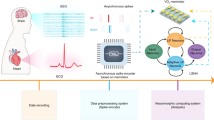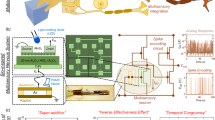Abstract
Neuromorphic computing has been widely developed due to its low power consumption and powerful interpretability. LIF neurons, the general-purpose neurons in neuromorphic computing, are under constant research in hardware implementations of spiking neural networks. In this paper, we design a LIF circuit with MOSFET based on the mathematical model of the LIF neuron. The simulated circuit can be directly applied to the spiking neural network through the VTEAM memristor crossbar architecture. The effect of parameter changes in the circuit on the membrane potential is demonstrated. Finally, we validate feasibility of the process on the DVS128 gesture dataset using a generic spiking neural network architecture and obtain satisfactory performance.
This research was funded by the Natural Science Foundation of Shaanxi Province (Grant No. 2022JQ-661) and the Fundamental Research Funds for the Central Universities (Grant No. XJS222215).
Access this chapter
Tax calculation will be finalised at checkout
Purchases are for personal use only
Similar content being viewed by others
References
Maass, W.: Networks of spiking neurons: the third generation of neural network models. Neural Netw. 10(9), 1659–1671 (1997)
Gerstner, W., et al.: Neuronal Dynamics: From Single Neurons to Networks and Models of Cognition. Cambridge University Press, Cambridge (2014)
Fang, W., et al.: Deep residual learning in spiking neural networks. In: Advances in Neural Information Processing Systems, vol. 34 (2021)
Fang, W., et al.: Incorporating learnable membrane time constant to enhance learning of spiking neural networks. In: Proceedings of the IEEE/CVF International Conference on Computer Vision (2021)
Yakopcic, C., Taha, T.M.: Energy efficient perceptron pattern recognition using segmented memristor crossbar arrays. In: The 2013 International Joint Conference on Neural Networks (IJCNN). IEEE (2013)
Amir, A., et al.: A low power, fully event-based gesture recognition system. In: Proceedings of the IEEE Conference on Computer Vision and Pattern Recognition (2017)
Hodgkin, A.L., Huxley, A.F.: A quantitative description of membrane current and its application to conduction and excitation in nerve. J. Physiol. 117(4), 500 (1952)
Gupta, A., Long, L.N.: Hebbian learning with winner take all for spiking neural networks. In: 2009 International Joint Conference on Neural Networks. IEEE (2009)
Indiveri, G.: A low-power adaptive integrate-and-fire neuron circuit. In: Proceedings of the 2003 International Symposium on Circuits and Systems, 2003, ISCAS 2003, vol. 4. IEEE (2003)
Kvatinsky, S., et al.: VTEAM: a general model for voltage-controlled memristors. IEEE Trans. Circ. Syst. II Express Briefs 62(8), 786–790 (2015)
Fang, W., et al.: SpikingJelly (2020). https://github.com/fangwei123456/spikingjelly
Author information
Authors and Affiliations
Corresponding author
Editor information
Editors and Affiliations
Rights and permissions
Copyright information
© 2022 IFIP International Federation for Information Processing
About this paper
Cite this paper
Fu, J., Gou, S., Guo, Z. (2022). Spiking Neuron Network Based on VTEAM Memristor and MOSFET-LIF Neuron. In: Shi, Z., Jin, Y., Zhang, X. (eds) Intelligence Science IV. ICIS 2022. IFIP Advances in Information and Communication Technology, vol 659. Springer, Cham. https://doi.org/10.1007/978-3-031-14903-0_5
Download citation
DOI: https://doi.org/10.1007/978-3-031-14903-0_5
Published:
Publisher Name: Springer, Cham
Print ISBN: 978-3-031-14902-3
Online ISBN: 978-3-031-14903-0
eBook Packages: Computer ScienceComputer Science (R0)





